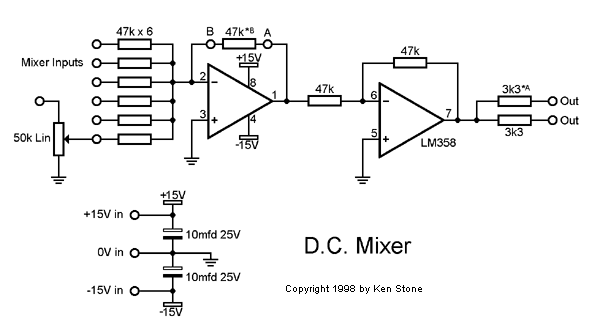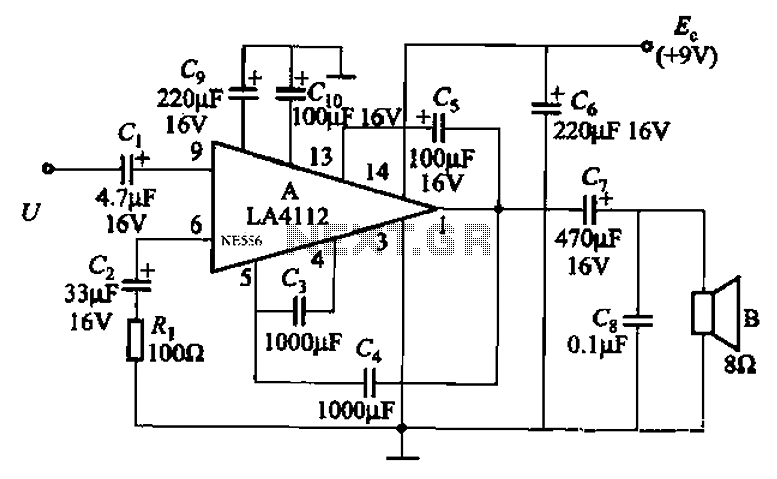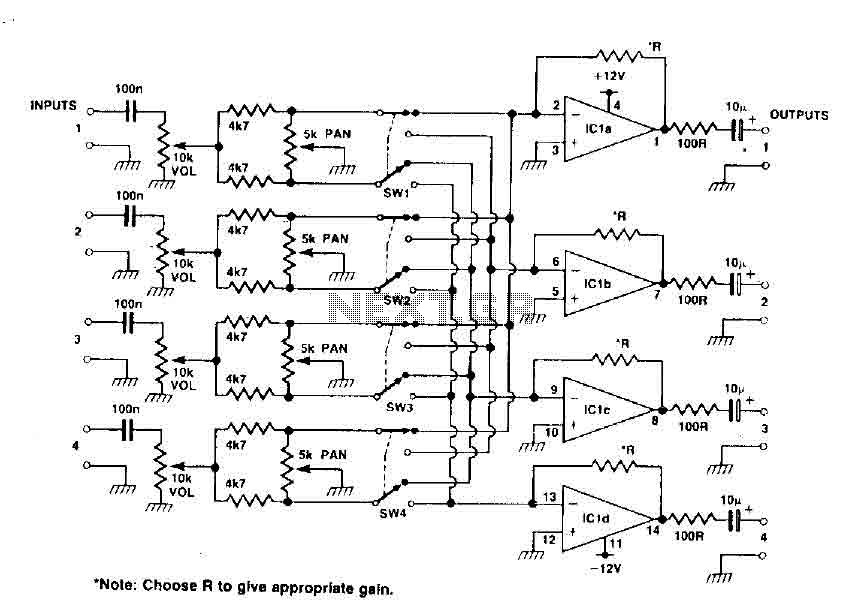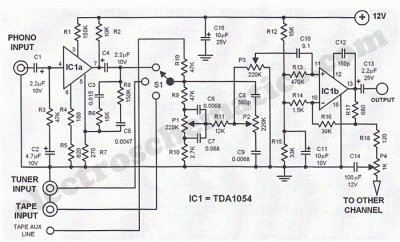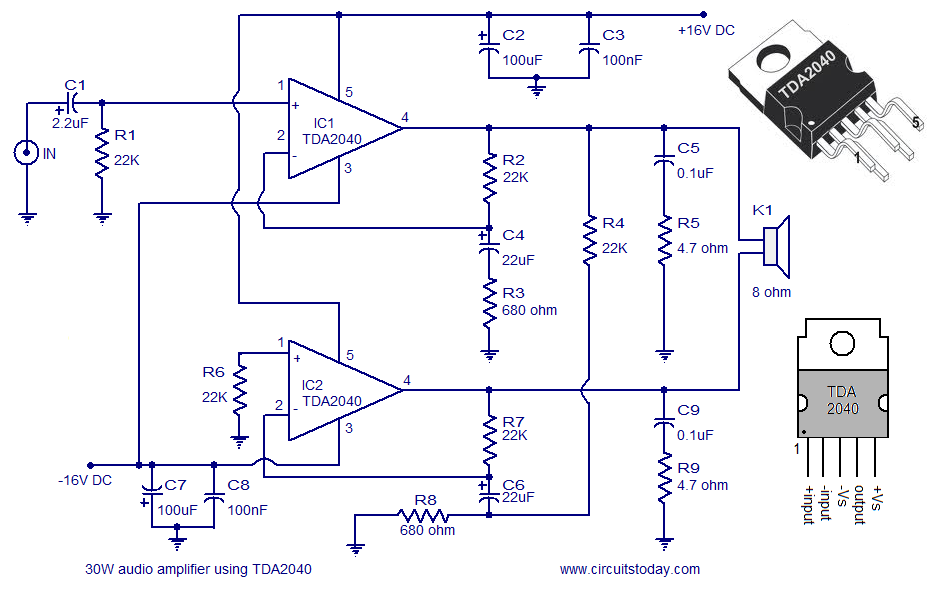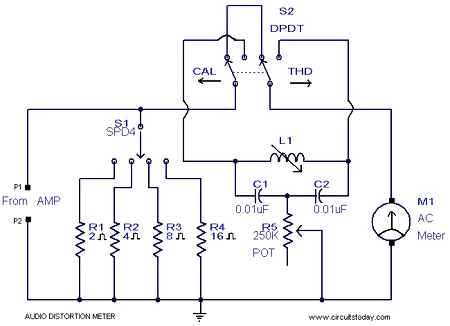
4 channel portable audio mixer 18
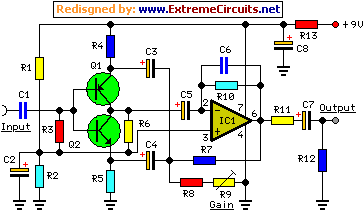
The objective of this project was to design a small, portable mixer powered by a 9V PP3 battery while maintaining high-quality performance. The mixer consists of three main modules that can be varied in number and/or arrangement to meet individual needs. The three main modules are: Input Amplifier Module, which is a low-noise circuit with a variable voltage gain (10 - 100) preset, primarily designed for high-quality microphone input but also suitable for low-level line input; Tone Control Module, which features a three-band (Bass, Middle, Treble) tone control circuit providing unity gain when its controls are set to a flat frequency response. This module can be placed after one or more Input Amplifier Modules and/or after the Main Mixer Amplifiers. The accompanying block diagram illustrates the entire mixer setup, including four Input Amplifier Modules followed by four switchable Tone Control Modules, one stereo line input, four mono main faders, one stereo dual-ganged main fader, four pan pots, a stereo Main Mixer Amplifier Module, and two additional switchable Tone Control Modules for each channel, inserted before the main left and right outputs. This layout can be rearranged as desired. A remarkable feature of this design is that the complete stereo mixer, as depicted in the block diagram, consumes less than 6mA of current. The basic circuit arrangement is derived from the old Quad magnetic pick-up cartridge module, adapted for microphone input and a single-rail low voltage supply. The low-noise, fully symmetrical, two-transistor head amplifier design allows for the use of a standard FET input operational amplifier as the second gain stage, even for highly sensitive microphone inputs. The amplifier's voltage gain can be adjusted via R9 from 10 to 100, equivalent to 20 to 40 dB. This design employs a modified Baxandall-type active circuitry to achieve a three-band control, with a total voltage gain of 1 when controls are in their center position. The schematic is represented as a stereo unit to clearly illustrate the input main fader and pan pot connections. The TL062 chip contains two TL061 op-amps in a single 8-pin package, configured as two virtual-earth mixer amplifiers with a voltage gain of approximately 4, compensating for losses due to the passive pan pot circuitry, resulting in a total voltage gain of 1. The components must be connected as shown in the circuit diagram, linking R3 and R4 to pin #2 and pin #6 of IC1 for the right and left channels, respectively. These pins serve as the "virtual-earth mixing points," capable of summing multiple channels. Additional components include a main on-off SPST switch, a pilot light LED with a 2.2kΩ 1/4W series resistor, DPDT switches to enable or bypass the Tone Control Modules as indicated in the block diagram, preferred input and output connectors, a stereo dual-gang 100kΩ potentiometer for fading the stereo line input, a battery clip, a PP3 9V battery, knobs, and other necessary elements.
The portable mixer circuit is structured to provide flexibility and high performance in a compact form factor. It is particularly advantageous for applications where space and power consumption are critical. The Input Amplifier Module's low-noise characteristics ensure that the audio quality remains high, even when handling sensitive signals. The variable gain feature allows users to adapt the mixer to different input levels, making it versatile for various audio sources.
The Tone Control Module enhances the audio output by allowing users to tailor the sound profile to their preferences, accommodating different musical styles or acoustic environments. The inclusion of multiple modules and the ability to rearrange them provides a customizable experience, enabling users to configure the mixer according to specific requirements.
The power efficiency of the design is noteworthy, with a total current draw of less than 6mA, making it suitable for battery-operated applications. This efficiency is achieved through careful selection of components and circuit topology, ensuring that the mixer performs well without excessive power consumption.
In summary, this portable mixer design combines functionality, flexibility, and efficiency, making it an excellent choice for musicians, sound engineers, or anyone in need of a reliable audio mixing solution in a compact package.The target of this project was the design of a small portable mixer supplied by a 9V PP3 battery, keeping high quality performance. The mixer is formed assembling three main modules that can be varied in number and/or disposition to suit everyone needs.
The three main modules are: Input Amplifier Module: a low noise circuit equipped with a variabl e voltage-gain (10 - 100) preset, primarily intended as high quality microphone input, also suitable for low-level line input. Tone Control Module: a three-band (Bass, Middle, Treble) tone control circuit providing unity-gain when its controls are set to flat frequency response.
It can be inserted after one or more Input Amplifier Modules and/or after the Main Mixer Amplifiers. The image below shows a Block diagram of the entire mixer featuring four Input Amplifier Modules followed by four in-out switchable Tone Control Modules, one stereo Line input, four mono Main Faders, one stereo dual-ganged Main Fader, four Pan-Pots, a stereo Main Mixer Amplifier Module and two further Tone Control Modules switchable in and out for each channel, inserted before the main Left and Right outputs. Obviously this layout can be rearranged at everyone wish. An astonishing feature of this design lies in the fact that a complete stereo mixer as shown below in the Block diagram draws less than 6mA current!
The basic arrangement of this circuit is derived from the old Quad magnetic pick-up cartridge module. The circuit was rearranged to cope with microphone input and a single-rail low voltage supply. This low-noise, fully symmetrical, two-transistor head amplifier layout, allows the use of a normal FET input Op-Amp as the second gain stage, even for very sensitive microphone inputs.
The voltage-gain of this amplifier can be varied by means of R9 from 10 to 100, i. e. 20 to 40dB. This is a straightforward design using the Baxandall-type active circuitry slightly modified to obtain a three-band control. Total voltage gain of this module is 1 when controls are set in their center position. The schematic of this circuit is drawn as a stereo unit to better show the input Main Fader and Pan-Pot connections.
The TL062 chip contains two TL061 op-amps into the same 8 pin case and is wired as two virtual-earth mixer amplifiers having a voltage gain of about 4, to compensate for losses introduced in the passive Pan-Pot circuitry. Therefore, total voltage-gain is 1. These parts must be wired as shown in the above circuit diagram, connecting R3 and R4 to pin #2 and pin #6 of IC1 for Right and Left channel respectively.
These IC1 pins are the "virtual-earth mixing points" and can sum together a great number of channels. To parts listed above should be added: one Main on-off SPST switch, a LED used as pilot-light with its dropping 2K2 1/4W series-resistor, DPDT switches to enable or omit Tone Control Modules as shown in the Block diagram, input and output connectors of the type preferred, one stereo dual-gang 100K potentiometer to fade the Stereo Line Input as shown in the Block diagram, battery clip, PP3 9V battery, knobs etc.
🔗 External reference
The portable mixer circuit is structured to provide flexibility and high performance in a compact form factor. It is particularly advantageous for applications where space and power consumption are critical. The Input Amplifier Module's low-noise characteristics ensure that the audio quality remains high, even when handling sensitive signals. The variable gain feature allows users to adapt the mixer to different input levels, making it versatile for various audio sources.
The Tone Control Module enhances the audio output by allowing users to tailor the sound profile to their preferences, accommodating different musical styles or acoustic environments. The inclusion of multiple modules and the ability to rearrange them provides a customizable experience, enabling users to configure the mixer according to specific requirements.
The power efficiency of the design is noteworthy, with a total current draw of less than 6mA, making it suitable for battery-operated applications. This efficiency is achieved through careful selection of components and circuit topology, ensuring that the mixer performs well without excessive power consumption.
In summary, this portable mixer design combines functionality, flexibility, and efficiency, making it an excellent choice for musicians, sound engineers, or anyone in need of a reliable audio mixing solution in a compact package.The target of this project was the design of a small portable mixer supplied by a 9V PP3 battery, keeping high quality performance. The mixer is formed assembling three main modules that can be varied in number and/or disposition to suit everyone needs.
The three main modules are: Input Amplifier Module: a low noise circuit equipped with a variabl e voltage-gain (10 - 100) preset, primarily intended as high quality microphone input, also suitable for low-level line input. Tone Control Module: a three-band (Bass, Middle, Treble) tone control circuit providing unity-gain when its controls are set to flat frequency response.
It can be inserted after one or more Input Amplifier Modules and/or after the Main Mixer Amplifiers. The image below shows a Block diagram of the entire mixer featuring four Input Amplifier Modules followed by four in-out switchable Tone Control Modules, one stereo Line input, four mono Main Faders, one stereo dual-ganged Main Fader, four Pan-Pots, a stereo Main Mixer Amplifier Module and two further Tone Control Modules switchable in and out for each channel, inserted before the main Left and Right outputs. Obviously this layout can be rearranged at everyone wish. An astonishing feature of this design lies in the fact that a complete stereo mixer as shown below in the Block diagram draws less than 6mA current!
The basic arrangement of this circuit is derived from the old Quad magnetic pick-up cartridge module. The circuit was rearranged to cope with microphone input and a single-rail low voltage supply. This low-noise, fully symmetrical, two-transistor head amplifier layout, allows the use of a normal FET input Op-Amp as the second gain stage, even for very sensitive microphone inputs.
The voltage-gain of this amplifier can be varied by means of R9 from 10 to 100, i. e. 20 to 40dB. This is a straightforward design using the Baxandall-type active circuitry slightly modified to obtain a three-band control. Total voltage gain of this module is 1 when controls are set in their center position. The schematic of this circuit is drawn as a stereo unit to better show the input Main Fader and Pan-Pot connections.
The TL062 chip contains two TL061 op-amps into the same 8 pin case and is wired as two virtual-earth mixer amplifiers having a voltage gain of about 4, to compensate for losses introduced in the passive Pan-Pot circuitry. Therefore, total voltage-gain is 1. These parts must be wired as shown in the above circuit diagram, connecting R3 and R4 to pin #2 and pin #6 of IC1 for Right and Left channel respectively.
These IC1 pins are the "virtual-earth mixing points" and can sum together a great number of channels. To parts listed above should be added: one Main on-off SPST switch, a LED used as pilot-light with its dropping 2K2 1/4W series-resistor, DPDT switches to enable or omit Tone Control Modules as shown in the Block diagram, input and output connectors of the type preferred, one stereo dual-gang 100K potentiometer to fade the Stereo Line Input as shown in the Block diagram, battery clip, PP3 9V battery, knobs etc.
🔗 External reference
